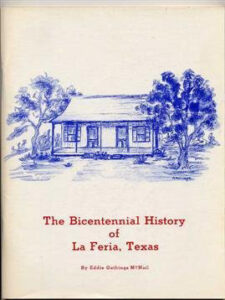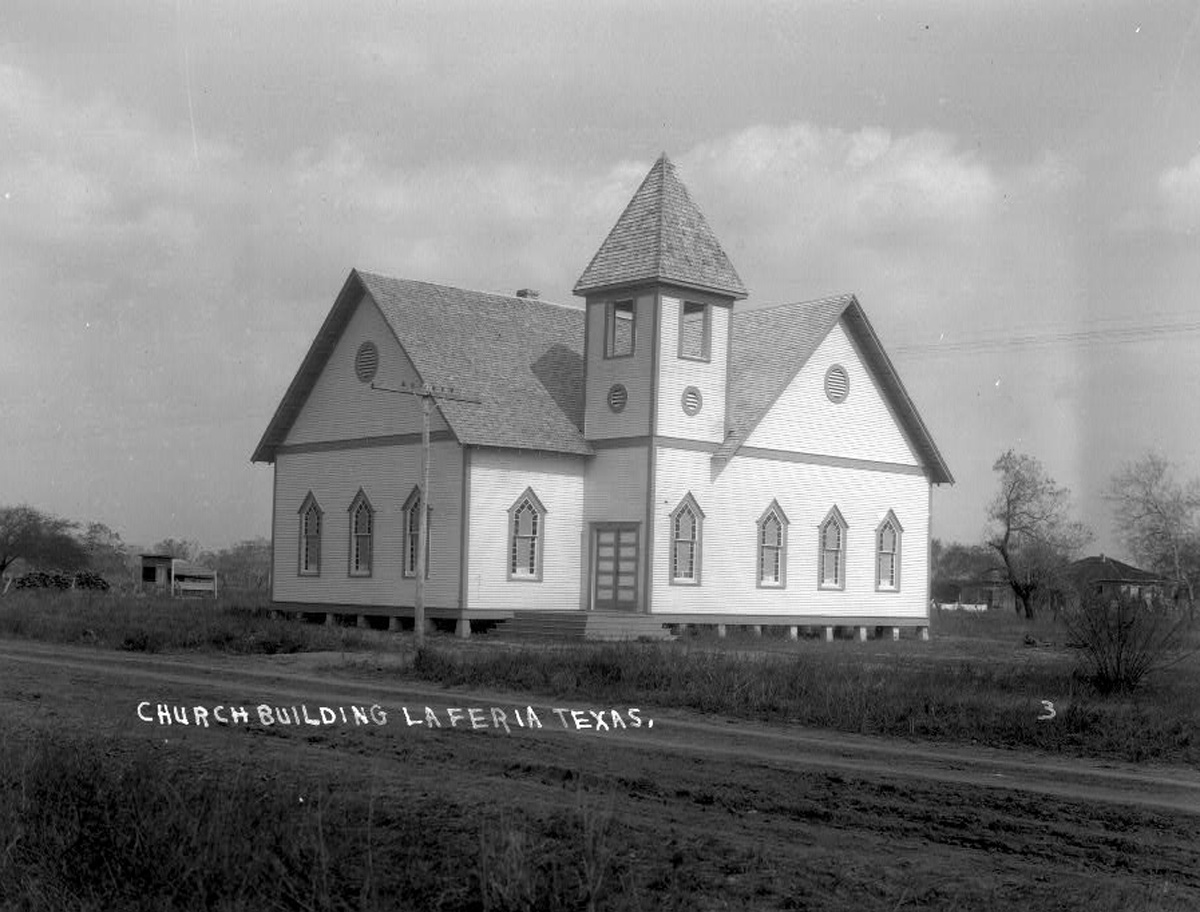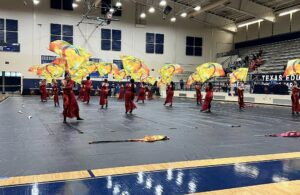- La Feria Community Holds Succesful Business Mixer Event
- Little Nashville to Take Place in Downtown Mercedes
- Lions Basketball Captures District Gold
- La Feria ISD Students Compete in Regional Chess Tournament
- Lions End First Half of 32-4A on a High Note
- La Feria ISD Held Another Successful Parent Conference
- Strong Appearance for Lions at Hidalgo Power Meet
- LFECHS Students Get to Meet Local Actress
- Students Participate in Marine Biology Camp
- Two LFECHS Students Qualify for All-State Band
The Union and the First Methodist Church: Part Two
- Updated: October 2, 2015

The city of La Feria is celebrating its 100th year anniversary and to commemorate the occasion we are digging deep into our archives each week to bring you images and stories from La Feria’s colorful past.
 |
The following story is a chapter from a manuscript entitled The Bicentennial History of La Feria, Texas written by Eddie Gathings McNail in 1975. Throughout the coming year we’ll be reprinting sections of her research into the history of La Feria as the city celebrates its 100 year anniversary. |
Editor’s Note: For the next few weeks we will be publishing Ms. McNail’s prodigeous chapter on the history of La Feria’s First Methodist Church. La Feria News would like to invite the congregations of St. Francis Xavier Catholic Church, New Hope Presbyterian Church of La Feria, and the First Baptist Church of La Feria to please submit any historical photos they may have related to their respective churches. Our archive has many photos of the Methodist church but none of the Catholic and Baptist churches. Please bring any photos by our office or email scans to news@laferianews.net. Thank you!
From 1932 to 1934, the Rev. Stanley R. Harwood was the pastor of the La Feria charge with the Rev. E. A. Hunter as District Superintendent. During this period the Church School made decided growth and progress as the attendance frequently reached the 200 mark. D. S. Knight retired as General Superintendent during this time and J. B. Smith succeeded him.
The Children’s Division did splendid work under the direction of Miss Wilda Holcomb, one of our efficient teachers in the La Feria Public Schools. Miss Nellie Howarth carried on the work after Miss Holcomb’s marriage to Kenneth Keith.
The Men’s Bible class with J. T. Butcher, Sr., as teacher was a force for good in the church. The Young Women’s class, which was later known as the Grace Mitchell Class, was reorganized by Mrs. Harmon Straub with Mrs. Stanley Harwood as its teacher.
The Wesley Fellowship, composed of the older young people, was very active in its work with Miss Elberta Wiley and Kynett Mitchell as faithful workers.
The Choir Director during this period was Rev. Harwood with Mrs. J. B. Smith as pianist, Mrs, D. S. Knight and Mrs. Wemple Sanders as soprano soloists and Lowell Clark as tenor soloist.
During 1932, the men of the church put a new roof on the old church and redecorated the interior of the sanctuary. The ladies of the church and of the Women’s Society of Christian Service assisted by serving dinners to the men while this work was being done and by having “penny” suppers to supplement funds for the repairs.

An undated photo of the original First Methodist Church in La Feria (circa 1900-1920). Photo: Robert Runyon Photograph Collection/The Center for American History and General Libraries, University of Texas at Austin
In September, 1933, a hurricane descended upon the Valley with its wind, water and destruction. The Church, the educational unit and the parsonage were greatly damaged. However, the new roof saved the church from total destruction, and, through the work of the churchmen under the direction of Ed Lindberg, the church was bolted together, the parsonage was roofed and repaired, and the educational building was remodeled with sheetrock and textone and painted.
The parsonage debt was reduced and much progress was made by the local church.
Rev. Harwood was succeeded by Rev. J. C. Wilson, who came from Edna, Texas, with E. A. Hunter and Charles Nixon as Presiding Elders. These three years finished Rev. Wilson’s forty-sixth year in the active ministry.
One distinctive feature was the Methodist and the Presbyterian services uniting during the summer months, alternating between the two churches. This proved very pleasant and helpful.
Some improvements were made as curbing was put around part of the church property and the balance of the parsonage debt was finally paid. Times were hard as the depression was with us and most people had little on which to live.
A freeze threatened the spring crops during this interval; many farmers were out of church covering tomatoes and banking trees. Rev. Wilson was blind for some fifteen years before he died at the age of eighty-six. He was a man of God who gave of his time, effort and money in the service of the Methodist Church.
Part of his salary was used to pay on the church debt.
Late in October of 1938 the J. Chess Loverns arrived in La Feria to be the pastor of the Methodist Church, with his wife as his helper. This was their first visit to the Rio Grande Valley, and they were charmed with the citrus, flower and vegetable gardens lining the highways, with tall, stately palms lifting their heads against the horizons in all directions.
1938 was still a depression year and, although the people were selling their vegetables and fruit below production costs and although nobody had very much cash money, the spiritual vitality of the church was unimpaired. The very physical hardships strengthened the spiritual life of the church fellowship.
From the beginning the members were doing something to improve the facilities. With their own hands they did painting, carpenter work, plastering, concrete pouring and yard landscaping.
Chess Lovern was a decided part of the physical labor and together theygrew in the stature of good churchmanship.
The church attendance, including the Wednesday evening prayer meeting, was excellent; the congregational singing was outstanding. The young people, and there were many, followed his leadership so that there was a dedicated, spiritual growth of the church.
As Rev. Raymond E. Wilson followed Chess Lovern, he had a difficult place to fill both in the church and in the hearts of the congregation. Also, floods came and dampened the enthusiasm and hopes of the people. The church debt was still with us, and the picture was quite bleak and dark.
However, the work began to move forward with renewed interest because there was a fair price for the citrus and vegetable crops and a good revival winding up the year.
Roy H. May served as pastor of the First Methodist Church from June 1, 1942 to November, 1945. His ministry was a “wartime” ministry during World War II when there were anxieties of those at home about loved ones in the service as well as keeping in contact by correspondence with those in the service.
An outstanding accomplishment from the financial side was the paying of the indebtedness on the buildings which had burdened the church for ‘several years. At the time of payment,
March 1, 1943, the indebtedness was about $2,200. Relieved from the burden, the church began to talk in terms of a new building. In the fall of 1943, the church had nearly $2,500 in the building fund. This money came from a twenty-acre orchard that was given to the church by Mr. McDonald of Illinois.
One of the outstanding happenings occurred in La Feria because Asa Moore bought the orchard for $16,000 on the 4th of March, 1945. Methodism was taking its “Crusade for Christ” offering for relief and for rehabilitation work following the war. LaFeria’s quota was $989.80. Considerable discussion had taken place as to whether or not the church should or could pay it. After a careful and prayerful presentation of the matter to the membership, the offering was taken on the morning of March 4, 1945. The congregation came to the front and placed their gift on the table prepared for it; $1,639.30 was placed on that table! The significant thing was not that the members paid or overpaid the amount asked for, but the spirit of dedication in which it was given. There was a Spirit present in the church that day.
A small one-room building was purchased to be used as the minister’s study and as a Sunday School room. It was the first study that the pastor had outside of the parsonage. Some of the members had much fun teasing Rev. May about being in the “dog house”.
Rev. Leslie A. McDaniel came to La Feria in October, 1945, after serving in Hallettsville, Texas, for five years. He arrived at the right time of the year to witness the citrus orchards, the truck farms and the palm trees which made a picturesque scene that was beautiful. The palm trees against the full moon was a perfect picture.
Perry Bond and Roland Post were the welcome committee who made the McDaniels feel at home.
The membership of the church was 314 with 194 enrolled in Sunday School. The equipment was composed of a frame church building that accommodated four Sunday School classes during the Sunday School hour. The old parsonage had been converted into an educational building that housed the children’s division.
There was talk of building a new church plant; therefore, the big job was to plan for such a building program. Committees were set up and the work got underway. What style of building and the shape of the building that would be desired had to be determined. Mrs. Josh Sanders came to the rescue and drew a picture of such a building. The drawing is on the wall of the pastor’s study today. A floor plan was drawn to indicate accommodations for each department of the Sunday School and each organization of the church.
A. L. Brovey was chairman of the official Board during the most difficult time of the building program.
Roland Post headed the finance drive to build the new church. On the morning designated for the drive, the teams met in the annex for breakfast, chose names and started to work.
The teams were met with sad news because there was no price quoted on citrus. In the face of this, many of the members gave a very good response.
Mr. Henry Steinbomer, architect of San Antonio, was invited to consult with the building committee and was employed to draw up the final plans for the building. Ted Akin was elected chairman of the building committee and, through his contacts, materials were bought at cost, or cost plus ten per cent, and the lumber was bought at mill price.
The wood beams on the ceiling, as called for by the architect in blueprint, were submitted to a Valley contractor for the making and the installation. The bid was $2,700.00.
The building fund at that time was such that the finances to pay for this bid were net available.
Redwood was bought in San Benito, hauled to Mr. W. Caffee’s wood mill in Primera by Kynett Mitchell to be cut and built and returned to La Feria by H. M. Smithey and Son. Galvanized nails were used in the redwood beams because acid in the redwood will rot common nails. After a search in some twenty-two hardware stores and lumber yards, the special nails were found at the South Texas Lumber Company in San Benito. The total cost of the beams was $690, which was a saving of $2,010.00 to the church above the contract offer.
Henry Hunt was employed by the building committee to construct the building. The educational building was to be built first, followed by the sanctuary. The foundation and the walls of the educational building were completed when a gust of wind hit some forty trusses that had been put up and temporarily nailed. A truss hit the one next to it and down went all the trusses like dominoes falling. The impact of the trusses broke down the walls. No one was hurt, but the walls had to be rebuilt and the trusses repaired. The building was almost completed when the freeze came in January of 1949.
The citrus in the orchards was ruined; the trees were damaged. Therefore, the money that was expected to come in from the citrus crops did not materialize. The building program stopped. The men were laid off. The church owed $8,000.00 for materials and labor.
Money was borrowed at the First National Bank to take care of the urgent bills. Some twenty feet of the walls and the roof of the sanctuary had been built. Here the material on hand was stored. The fellowship hall of the new building became the sanctuary for the time being. Rev. Charles Marshall, District Superintendent, was present for the opening services of the new educational building.
The old church which had served its time was purchased by the General Board of the Methodist Missions through the superintendent of Latin-American work, Ezequiel Alvirez of McAllen.
The First Methodist Church of Harlingen advanced the $2,000.00 which was later reimbursed by the General Board of Missions.
Joseph Covington McNail’s funeral was the last service in the old church on January 30, 1950.
This building was sold by the La Feria Methodist official Board in order to erect a $56,000.00 stone building.
Do YOU have any photos, books, or stories that might help us piece together La Feria’s storied history? If so please email us or call our office at 956-797-9920 and let us know!


